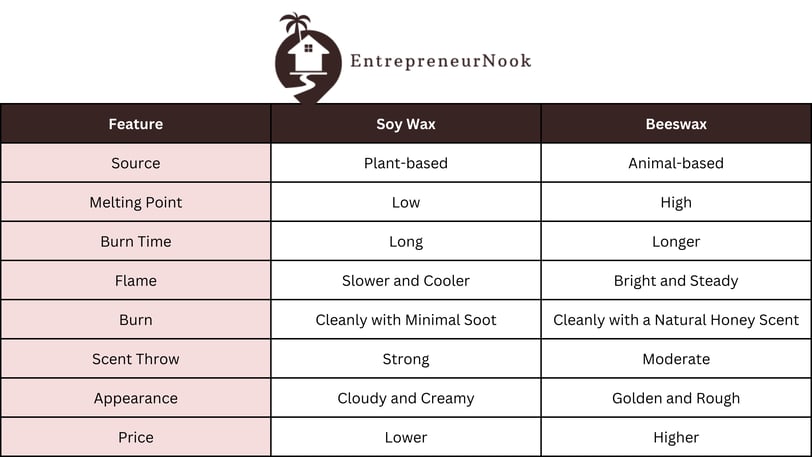Soy Wax vs. Beeswax
A Candlemaker's Guide
CANDLE-MAKING
10/15/2024


When crafting candles, the choice of wax significantly impacts the final product's burn characteristics, scent throw, and overall aesthetic. Two popular options are soy wax and beeswax, each with its own unique qualities. Let's delve into the key differences between these two waxes to help you make an informed decision.
Soy Wax
Source: Soy wax is derived from soybeans, making it a plant-based, renewable resource. Soybeans are harvested, and the oil is extracted and hydrogenated to create the wax.
Burn Characteristics: Soy wax has a relatively low melting point, which results in a slower, cooler burn. Soy wax burns cleanly, producing minimal soot and a slower burn rate compared to paraffin wax.
Scent Throw: Soy wax is excellent for holding and releasing fragrance oils, making it a popular choice for scented candles. Its slow-burning nature allows for a consistent, long-lasting scent throw. If you want to create candles with strong, custom fragrances, soy wax might be the better option.
Appearance: Soy wax is smooth, creamy, and opaque when solidified. It can hold dyes well, making it ideal for crafting colorful candles. However, soy wax can sometimes develop "frosting" (a white, crystalline coating), which is harmless but may affect the visual appeal.
Sustainability: As a plant-based product, soy wax is considered more environmentally friendly than paraffin wax.
Health Benefits: Soy wax burns cleanly, producing minimal soot, making it a healthier option for indoor use.
Beeswax
Source: Beeswax is a natural byproduct of honey production, created by bees to build their honeycombs. It’s a renewable resource but is produced in smaller quantities compared to soy.
Timeless and Premium: It is one of the oldest materials used for candle-making, dating back to ancient times, and is considered a premium wax due to its purity and limited availability.
Burn Characteristics: Beeswax burns at a higher temperature than soy wax, resulting in a longer burn time. Beeswax burns cleanly and produces a honey-like scent. It has a slightly harder texture and a slower burn rate than soy wax.
Scent Throw: Beeswax has a natural, light honey scent, which can complement or interfere with added fragrances. While beeswax can hold fragrance oils, its natural aroma may overpower more delicate scents. However, many people prefer beeswax for its subtle, natural scent.
Appearance: Beeswax has a rich, golden hue and a harder texture than soy wax. It is often left in its natural color, ranging from pale yellow to deep amber. Because of its harder consistency, beeswax is not as easy to color as soy wax, but its natural aesthetic appeals to those who prefer a rustic or traditional look.
Sustainability: While beeswax is a natural product, there are concerns about the impact of commercial beekeeping on bee populations.
Health Benefits: When burned, Beeswax releases negative ions that help neutralize pollutants, allergens, and dust which can help purify the air by neutralizing pollutants.
Takeaways from EntrepreneurNook
Both soy wax and beeswax are fantastic natural alternatives to paraffin, each with its own unique advantages. If you’re looking for an affordable, customizable option that holds fragrance well, soy wax is a great choice. It’s ideal for those who want long-lasting, scented candles with a smooth, even burn.
👉 Direct Purchase American Organic Soy Wax on Amazon.
👉 Direct Purchase Premium Natural Soy Wax on Amazon.
On the other hand, if you prefer something more traditional, with a natural honey scent and air-purifying qualities, beeswax might be the perfect option. Although pricier, beeswax is a premium, eco-friendly choice that offers health benefits and a beautiful, bright burn.
👉 Direct Purchase Organic White Beeswax Pellets on Amazon.


EntrepreneurNook
Combine minds, ignite ideas.
Contact
© 2024. All rights reserved.
